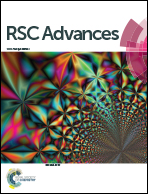Stability studies of ionic liquid [EMIm][NTf2] under short-term thermal exposure†
Abstract
Ionic liquids (ILs) as new media for synthesis and as functional fluids in technical applications are still of high interest. Cooling a steel component from an annealing temperature of nearly 850 °C down to room temperature in a liquid bath is a technically important process. The use of ionic liquids offers advantages avoiding film boiling of the quenching medium. However, such a high immersion temperature exceeds the thermal stability of the IL, for example such as [EMIm][NTf2]. To obtain information about formation of potential toxic decomposition products, potential fragments at varied states of decomposition of [EMIm][NTf2] were studied by various spectroscopic and gravimetric methods. For the first time it was possible to quantify fluorine-containing products via mass spectrometry coupled directly with thermogravimetric (TG) measurements. While chemical and spectroscopic analysis of thermally stressed ILs revealed no hints concerning changes of composition after quenching hot steel for several times, the mass-spectrometer (MS) coupled TG analysis gives information by comparing the decomposition behaviour of fresh and used ILs. A number of fragments were detected in low amounts confirming the proposed decomposition mechanism.
![Graphical abstract: Stability studies of ionic liquid [EMIm][NTf2] under short-term thermal exposure](/en/Image/Get?imageInfo.ImageType=GA&imageInfo.ImageIdentifier.ManuscriptID=C6RA06129J&imageInfo.ImageIdentifier.Year=2016)

 Please wait while we load your content...
Please wait while we load your content...